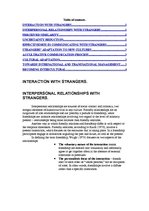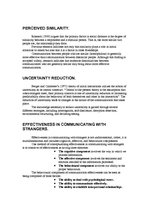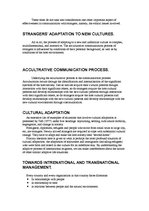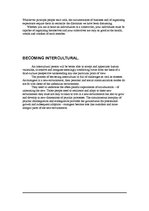-
Strangers, Intercultural
| Nr. | Sadaļas nosaukums | Lpp. |
| INTERACTION WITH STRANGERS | 1 | |
| INTERPERSONAL RELATIONSHIPS WITH STRANGERS | 1 | |
| PERCEIVED SIMILARITY | 2 | |
| UNCERTAINTY REDUCTION | 2 | |
| EFFECTIVENESS IN COMMUNICATING WITH STRANGERS | 2 | |
| STRANGERS’ ADAPTATION TO NEW CULTURES | 3 | |
| ACCULTRATIVE COMMUNICATION PROCESS | 3 | |
| CULTURAL ADAPTATION | 3 | |
| TOWARDS INTRENATIONAL AND TRANSNATIONAL MANAGEMENT | 3 | |
| BECOMING INTERCULTURAL | 4 |
Interpersonal relationships are sources of social contact and intimacy, two integral elements of human survival in any culture. Friendly relationships are an outgrowth of role relationships and are possibly a prelude to friendship, while friendships are intimate relationships involving two regard to the level of intimacy present – relationships being more intimate than friendly relations.
Another way in which friendly relations and friendship differ is with respect to the temporal dimension. Friendly relations, according to Kurth (1970), involve a present orientation, which focuses on the encounter that is taking place. In a friendship participants engage in interaction regarding the past and future, as well as the present.
In defining the term friendship, Wright (1978) focuses on two aspects of the relationships:
The voluntary nature of the interaction means friendship are entered into voluntarily and informally agree to get together often in the absence of external constrains or pressures.…
INTERACTION WITH STRANGERS. 1
INTERPERSONAL RELATIONSHIPS WITH STRANGERS. 1
PERCEIVED SIMILARITY. 2
UNCERTAINTY REDUCTION. 2
EFFECTIVENESS IN COMMUNICATING WITH STRANGERS. 2
STRANGERS’ ADAPTATION TO NEW CULTURES. 3
ACCULTRATIVE COMMUNICATION PROCESS. 3
CULTURAL ADAPTATION 3
TOWARDS INTRENATIONAL AND TRANSNATIONAL MANAGEMENT. 3
BECOMING INTERCULTURAL. 4





